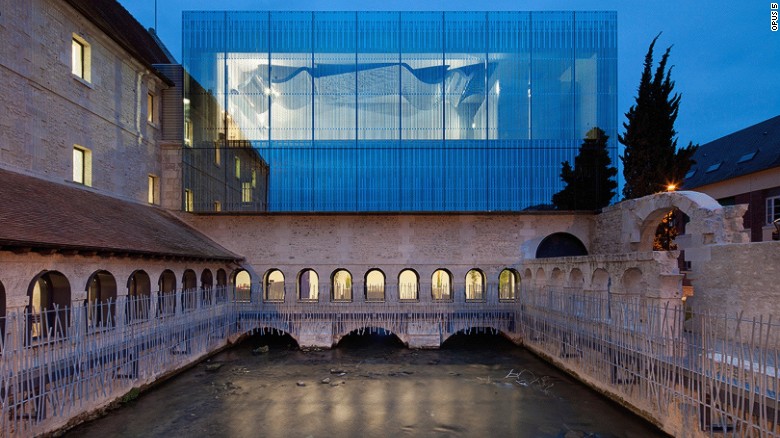The United States may be known as the "incarceration nation," with about 1% of its population behind bars, but after decades of aggressive sentencing, the number of inmates is finally on the decline.
In fact, prison populations are plummeting the world over from the Netherlands to Jamaica -- and fewer inmates means fewer prisons.
While some decommissioned jails rot away like best-forgotten eyesores, others have found surprising second lives as everything from luxury hotels to concert halls and wedding venues.
Here's a look at nine unusual life-after-prison stories in which former jails have opened their gates to start anew.
Hostel Celica (Ljubljana, Slovenia)
Slovenia's most popular hostel is located in the most unlikely of buildings: a former Yugoslavian military prison.
Guests at Hostel Celica sleep behind bars thanks to a creative facelift that's left the building with 20 artistically redesigned jail cells -- each with its own distinct flavor.
Renovation of this Ljubljana icon -- in the hands of the Yugoslav federal army until 1991 -- took 10 years and 80 artists. It finally opened to the public in 2003, transforming what was once a place of confinement into a place of open ideas and cross-cultural exchange.
The former prison is also home to an art gallery with a cultural program that includes regular concerts, workshops, poetry readings and philosophical debates.
Cultural Park of Valparaiso (Chile)
A jail in Chile's beloved port city used to detain political prisoners during the dictatorship of Augusto Pinochet, Valparaiso Prison closed in 1999 and re-opened in 2013 as the Cultural Park of Valparaiso.
Chilean architecture studio HLPS completely transformed this site of reclusion into an integrated open space that straddles one of the city's 45 urban hills.
The center offers a mixed bag of activities, from rotating gallery exhibitions in the old cell blocks to classes, live theater and dance in a modern 307-seat theater.
It's also home to an expansive public park with newly planted trees and great views out over the Pacific Ocean below.
Pentridge Prison (Melbourne, Australia)
This jail 15 minutes north of the city's CBD was built in 1851, decommissioned in 1997 and recently converted into a hip space for everything from weddings to fashion shows, conferences and cocktail parties.
Forthcoming events include a craft beer festival in September and a "prison sleepover" on August 29 where visitors can experience what prison life was like and get locked up in their cell for the night.
Pentridge will also house a pop-up beer garden, The Hop Thief, from December 2015 to March 2016. Located in the prison's notorious D Division, guests will be able to throw back James Squire beers and chow down on steak sandwiches -- delicacies the former tenants could only dream about.
Centro Cultural Antigua Carcel - Le Crac (Palencia, Spain)
Exit Architects did a superb job of transforming the dark and heavy shell of this former prison complex into an airy cultural center in Palencia, Spain.
Playing off the 19th century building's Neo-Mudejar style, the architects added in skylights and zinc panels fitted with translucent "windows" to flood the space with light.
Now, it maintains a penal feel without giving off claustrophobic jitters.
Palencia Provincial Prison may have locked the world out, but the new cultural center's four wings invite people in. Visitors can check out events in the auditorium, read in a library and learn in classrooms offering lessons in art and music.
Museum of Belize (Belize City)
A prison that once housed a nation's top criminals now safeguards its national treasures.
Her Majesty's Prison in Belize City dates back to 1855, when bricks known as "London Socks" were brought over from England to build a jail in the British colony.
The facility didn't close its doors until 1993 and spent the next decade undergoing refurbishments before the National Institute of Culture and History opened it as the Museum of Belize in 2002.
Exhibits span thousands of years from the reign of the Maya to modern-day Belize, covering its many cultural influences from Africa to Europe and beyond.
Four Seasons Istanbul at Sultanahmet (Turkey)
The prisoners who slept on stone slabs and ate bread with water would be rolling in their graves if they knew the current occupants of the old Sultanahmet Prison now nod off in king-size beds with the finest linens.
This jail -- which housed prominent artists like Aziz Nesin and Orhan Kemal and political dissidents like Mihri Belli -- became a Four Seasons hotel in 1996.
The modern-day luxury resort is a glamorous refuge to escape to, rather than from, but elements of the building's dour history remain visible on hand-painted tiles in the lobby, carvings on several marble pillars and within the landscaped courtyard, which once served as the prisoners' exercise yard.
Similar prison hotels around the world include Liberty Hotel in Boston, the Malmaison in Oxford and Het Arresthuis in Roermond, Netherlands.
Louviers Music School (Normandy, France)
The 17th-century Convent of the Penitents served as a prison in the 18th and 19th centuries and got a new life altogether in the 20th century when it reopened as a music school in 1990.
The biggest change, however, was yet to come.
A total revamp from French studio Opus 5 in 2012 gave the historic Normandy complex a two-level, glass-fronted extension that wraps over its southern wing.
On the top of the Louviers Music School is a concert hall with an undulating mirrored ceiling, while below lies a fully stocked music library.
Freedom Park Lagos (Nigeria)
Born out of the ruins of the notorious Broad Street Prison, Freedom Park Lagos opened in 2010 to commemorate 50 years of independence from Britain.
This airy leisure spot is a welcome respite from the congestion of Lagos Island, and was the brainchild of local architect Theo Lawson.
Lawson took what was once a colonial instrument of control and oppression and turned it into a peaceful place for contemplation and interaction.
The park includes a museum, art gallery, ponds, fountains, shops and restaurants.
It's also home to a popular amphitheater that stages live music, spoken word, drama, dance and poetry amid a packed cultural calendar.Laurel Hill (Lorton, Virginia)
A medium-security prison for Washington D.C. convicts located in nearby Virginia that closed in 2001, the Lorton Reformatory is currently being redeveloped into a mixed-use community.
The new neighborhood, rebranded as Laurel Hill, is one of the most talked about examples of adaptive reuse in the country.
It will retain much of the prison complex's original structure thanks to its listing on the National Register of Historic Places.
Retail establishments, office spaces and 225 apartments are all expected to take shape within refurbished cellblocks, guard towers and prison dorms.
One of the already finished highlights of the $188 million project is the Workhouse Arts Center, a collaborative visual and performing arts space with cooperative studios, educational facilities and galleries.
(CNN)









www.ann.az
Follow us !











